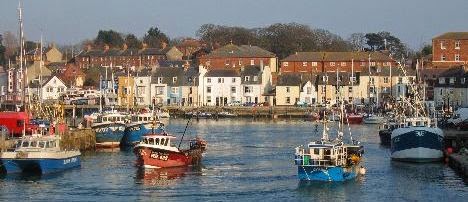The Earth Science Centre at Moon´s Quarry in Radstock.
Oh dear, I completely forgot to write up my blog about my visit to Whately and Moon's Quarries near Radstock in Somerset. A group of us from the Devizes U3A Geology group paid a second visit to the "Somerset Earth Science Centre," this time to visit both working quarries. The above photo shows the centre, which faces a lovely lake, complete with Canada geese and their babies! We all agreed, that this place would make a lovely private house.
Moon´s Quarry
This small quarry produces Andersite, a very hard rock, which is used to cover the very top of road surfaces, because it is so hard wearing.
The control centre at Whatley Quarry.
During our visit no one seemed to be on duty here, and we were left to wander around alone. The desk panels showed a diagrammatic view of the entire works, complete with what looked like a crocodiles snapping teeth, which represented the various stone crushers. Now fully mechanised, all these processes were done by hand!
Setting off in the minibus.
We had to stay inside the minibus with our safety hats on, which was a bit uncomfortable, but meant it might save our heads if a big boulder fell on top of the minibus!
A very big truck!
The rock is blown up with explosives, and then transported from the rock face to the crushing plant. It is tipped into huge stone crushers, and comes out the other end a small gravel chippings.
Whatley Quarry artificial lake.
We were able to get out of the minibus beside this artificial lake, naturally formed at the bottom of the quarry. It is very deep, as you can imagine, and will get deeper as the quarrying continues down. There is concern about how deep they can quarry without upsetting the balance of water supply in the area. No one is really certain where the hot springs at Bath originate, and digging here too deeply could make the warm water spring disappear!
.JPG)
.JPG)
.JPG)
.JPG)
.JPG)


.JPG)
.JPG)
.JPG)
.JPG)
.JPG)
.JPG)
.JPG)
.JPG)
.JPG)
.JPG)
.JPG)

.JPG)
.JPG)
.JPG)
.JPG)
.JPG)
.jpg)
.JPG)
.JPG)
.JPG)

.JPG)
.JPG)
.JPG)
.JPG)
.JPG)
.JPG)
.JPG)
.JPG)
.JPG)
.jpg)
.jpg)
.jpg)
.jpg)
.jpg)
.jpg)
.jpg)
.jpg)
.JPG)
.JPG)
.JPG)
.JPG)
.JPG)